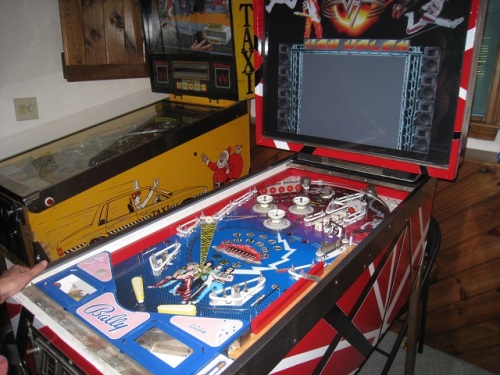My last entry didn’t really have much valuable information. I don’t want this blog to simply be about making a pinball machine, but helping others to follow the correct steps to make a pinball machine easier for them. So here are some quick tips.
Relax the vinyl for multiple days. When I received the vinyl, I immediately removed it from the tube and laid it flat. Side rails make nice weights to keep the vinyl flat when it is relaxing. I let it lay flat for about three days which really worked well. I believe that two days would have been sufficient.
Used the wet method to allow vinyl to float while placing. I made up a spray bottle with a couple cups of water and two dashes of liquid dish soap. I used a generous amount of water on both the bottom of the overlay and on the top of the playfield. Don’t be stingy. The more water you use, gives you that much more time to get placement right. Then, when everything is lined up, squeegee from the center of the playfield towards the edges.
On art, holes should not use dark circles, but should simply continue the artwork. That way if placement is a little off, it won’t be noticeable. Same thing with slots and holes for kickers, etc. There are plenty of inserts around, and those are really what matters for placement.
Holes should be on a separate layer on the art to make this process a lot easier. That way you could print a vinyl with the holes highlighted, then simply turn off that layer when printing the final version. I did a test print at kinkos of the playfield, but the test print was on very thin paper. Even using light to show from the bottom of the playfield, I couldn’t see that the inserts were 1/8 inch off. I really needed to print a clear overlay with just the location of the inserts. I could have easily done that before Joe did his artwork or even while Joe was doing his artwork and done that in parallel. Completely my fault, but I assumed the stitched image was going to be spot on. The reality is, that it is about .6% off. Truth be told, that is absolutely amazing, but it isn’t quite good enough for a playfield overlay.
Assume you will need to print two versions of the vinyl, but three would be that much safer. Vinyl takes about two weeks to receive using express shipping, so assume that you must have at least a month for that portion of the build. As stated above, it can be done in parallel with designing the artwork.
There is another possibility for the art error which is that the print is not perfectly sized. I should have put a border around the playfield art at an exact measurement of inches. As it was, the art went right to the edge of the print. If the printer modified the art slightly so it could be printed on their machine, it would show the same errors that I’m seeing. Again, my belief that the scan would be perfect was probably too optimistic.
This morning I used an xacto knife to cut out all the holes in the playfield, then applied the first coat of auto clear. Tomorrow morning I will apply a second coat of auto clear, and finally, tomorrow night I will apply the third coat. I might go for a fourth coat, but it really depends on what the third coat looks like. I think on SS3, I applied three coats. The first coat of auto clear makes the colors pop that much more. Nice!






















